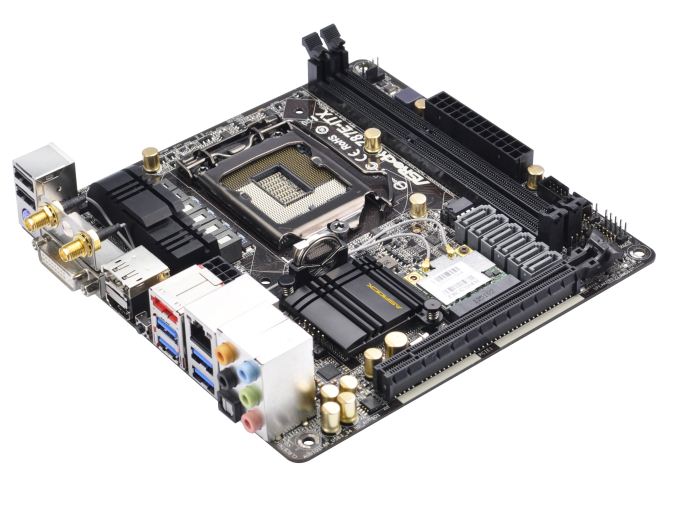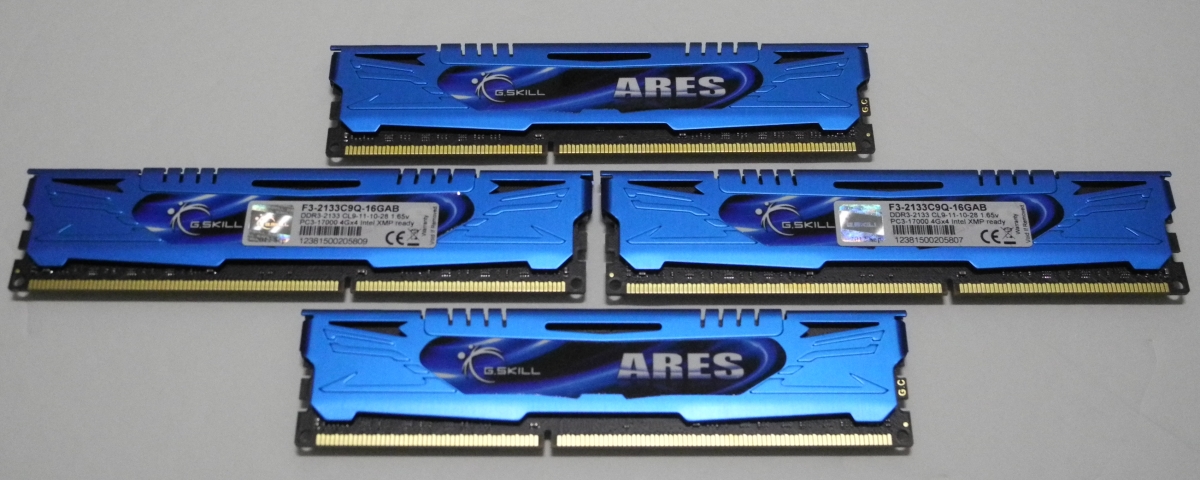Intel's Haswell - An HTPC Perspective: Media Playback, 4K and QuickSync Evaluated
by Ganesh T S on June 2, 2013 8:15 PM ESTTestbed and Software Setup
Instead of going for the usual high end CPU (77W / 95W TDPs), we have opted for the Core i7-4765T for today's review. This is a 35W TDP CPU with four cores / eight threads, expected to retail with a MSRP of $303. Intel has a number of GPU configurations doing the rounds at Haswell launch. The i7-4765T sports the HD 4600 GPU, and it is the best GPU available in a LGA 1150 configuration (The Iris Pro 5200 GPUs are reserved for BGA configurations and unavailable to system builders).
The table below presents the hardware components of our Haswell HTPC testbed
| Haswell HTPC Testbed Setup | |
| Processor | Intel Core i7-4765T - 2.00 GHz (Turbo to 3.0 GHz) |
| Intel HD Graphics HD4600 - Up to 1200 MHz | |
| Motherboard | ASRock Z87E-ITX mITX |
| OS Drive | Seagate 600 SSD ST240HM000 240GB |
| Memory | G.SKILL Ares Series 8GB (2 x 4GB) SDRAM DDR3 2133 (PC3 17000) F3-2133C9Q-16GAB CAS 9-11 -10-28 2N |
| Optical Drive | ASUS 8X Blu-ray Drive Model BC-08B1ST |
| Case | Antec Skeleton ATX Open Air Case |
| Power Supply | Antec VP-450 450W ATX |
| Operating System | Windows 8 Professional x64 |
| Displays / AVRs | Onkyo TX-SR606 + Acer H243H |
| Pioneer Elite VSX-32 + Sony Bravia KDL46EX720 | |
| Sony XBR-84X900 | |
| Seiki Digital SE50UY04 | |
The ASRock Z87E-ITX board comes with a Broadcom-based 802.11ac 2T2R solution. Connected to a Buffalo WZR-D1800H 802.11ac router, I was able to consistently obtain 173 Mbps of practical throughput. Streaming Blu-ray ISOs over Wi-Fi from a NAS worked without issues. The board was very simple to get up and running and given its form factor and the CPU currently installed, I hope to migrate it to a passive HTPC build soon.
The Haswell platform officially supports DDR3-1600. Towards this, we obtained a 16 GB DDR3-2133 Ares kit from G.Skill for our testbed. The Ares kit supports XMP 1.2 and the ASRock Z87E-ITX had it running at 2133 MHz flawlessly on first boot. However, we made sure to run the memory at the suggested 1600 MHz in order to obtain results consistent with what an average system builder (non-overclocker) would obtain. The Ares kit makes it possible to study HTPC behaviour from a memory bandwidth perspective, but we will not cover that aspect in this launch piece.
The software setup for the Haswell HTPC testbed involved the following:
| Haswell HTPC Testbed Software Setup | |
| Intel Graphics Driver | 9.18.10.3107 (Version on ASRock Motherboard DVD) |
| Blu-ray Playback Software | CyberLink PowerDVD 13 |
| Media Player | MPC-HC v1.6.7.7114 |
| Splitter / Decoder | LAV Filters 0.57 |
| Renderers | EVR / EVR-CP (integrated in MPC-HC v1.6.7.7114) |
| madVR v0.86.1 | |
The madVR renderer settings were fixed as below for testing purposes:
- Decoding features disabled
-
Deinterlacing set to:
- automatically activated when needed (activate when in doubt)
- automatic source type detection (i.e, disable automatic source type detection is left unchecked)
- only look at pixels in the frame center
-
Scaling algorithms were set as below:
- Chroma upscaling set to SoftCubic with softness of 100
- Luma upscaling set to Lanczos with 4 taps with anti-ringing filter left deactivated and scale in linear light left unchecked / DXVA2
- Luma downscaling set to Lanczos with 4 taps with anti-ringing filter left deactivated and scale in linear light left unchecked / DXVA2
-
Rendering parameters were set as below:
- Automatic fullscreen exclusive mode was used
- CPU and GPU queue sizes were set to 32 and 24 respectively
- Under exclusive mode settings, the seek bar was enabled, switch to exclusive mode from windowed mode was delayed by 3 seconds and 16 frames were configured to be presented in advance. The GPU flushing modes were set to default
- Smooth motion was left disabled
- The 'trade quality for performance' settings were left at default (i.e, linear light was left disabled for smooth motion frame blending and custom pixel shader results were stored in 16-bit buffers instead of 32-bit)
Unlike our Ivy Bridge setup, we found the windowed mode to be generally bad in terms of performance compared to exclusive mode.
MPC-HC and LAV Filters settings were altered from the defaults as below for testing purposes:
- DirectShow Video Output was configured as EVR / EVR-CP / madVR under Options > Playback > Output
- All internal source and transform filters were disabled under Options > Internal Filters
- Under Options > External Filters, LAV Splitter, LAV Audio Decoder and LAV Video Decoder were added as Preferred filters
- LAV Audio Decoder was set to bitstream all applicable formats
-
LAV Video Decoder were altered from the defaults as below
- Hardware Acceleration was set to DXVA2 Native / QuickSync / None depending on the aspect being tested. UHD (4K) was enabled in all the cases
- Deinterlacing mode was set to 'Aggressive'












95 Comments
View All Comments
StardogChampion - Monday, June 3, 2013 - link
I am wondering about this comment as well. Everything I've read seemed to indicate it would be available in mini-ITX form for building AIOs (so likely thin mini-ITX). Haswell will be a big disappointment without availability of the BGA packages in mini-ITX form.Sivar - Monday, June 3, 2013 - link
Thank you for the article.Note that x264 is a specific software encoder, not a type of video or a thing that can be accelerated ("While full x264 acceleration using QuickSync...")
H.264 is the video standard.
Also note that x264, the CPU-based encoding software, does not need to run in 2-pass mode to get great quality. 2-pass mode is ONLY if you want a specific file size regardless of quality. If you want a specific quality, you use quality mode. --CRF23, for example, returns small (though variable depending on content) file size and good quality.
ganeshts - Monday, June 3, 2013 - link
Sivar,I did specifically want to mention full x264 acceleration using QuickSync -- That is because x264 is the H.264 encoder of choice for many users. The most beneficial addition to the CPU would be the ability to get hardware acceleration when using x264 with ANY set of options. That is simply not going to be possible with QuickSync (or, for that matter, any hardware-based encoder).
Yes, agreed about the mistaken mention of 2-pass for improved quality. I will update it shortly.
Spawne32 - Monday, June 3, 2013 - link
People always fail to realize what key element in every one of these releases, how big the enthusiast market truly is. All of us posting here on this comment section regarding this review are a small fraction of the overall market intel targets, this is part of the reason AMD suffers so tragically with their current lineup. Power consumption and price are the two biggest factors in a regular consumers mind when purchasing a PC, be it laptop or desktop. Performance numbers rarely play a factor. I don't know what AMD is doing over there but I long for a day when AMD can actually challenge intel and drive prices down even further, because these 230-400 dollar starting prices for "mainstream" intel processors proves once again why I refuse to invest in them regardless of performance. The marginal increase in speed in my day to day activities does not warrant the price being paid for something that is obsolete in 1-2 years. AMD's highest priced processor right now is 179.99, its comparable intel counterpart in haswell....349.99, you do the math.bji - Monday, June 3, 2013 - link
Either the increases in speed with each successive generation are great enough to render previous generations obsolete, or the increases in speed with each successive generation are small enough that the previous generation is not rendered obsolete. You can't have it both ways just to try to make Intel look bad, sorry.I don't know what margin Intel is making on these parts - do you? Remember that they are sinking large R & D and transistor budgets into these minor speed increases, and at the same time sinking lots of money into developing the next generation of process technology. If $300 is not worth it to you, don't buy the part; Intel won't be able to sustain their R & D budgets if nobody buys the results.
Deuge - Monday, June 3, 2013 - link
If one of the GT3 or GT3e parts comes out in a refreshed NUC, id love to see a review of it from an HTPC perspective. Very interested to hear if it can handle Lanzcos + AR or Jinc.dbcoopernz - Monday, June 3, 2013 - link
Is the inability to use LAV with DXVA-native for madVR an Intel limitation? The devs of both the LAV filters and madVR have told me (on the doom9 forum) that DXVA-native is fine for madVR on AMD GPU's.BMNify - Monday, June 3, 2013 - link
DXVA native DOES work with AMD using LAV filters and MadVR... I'm using it as I type (watching MotoGP)ganeshts - Monday, June 3, 2013 - link
It also works with the Haswell piece. I will update the article ASAP.BMNify - Monday, June 3, 2013 - link
APU is the go to for HTPC builders. And stop with the power this and thermals that... undervolt it, toss in a Pico PSU, suspend to memory when not in use and enjoy. Take the hundreds saved and buy a Kabini or two as clients.If we're talking balls to the wall processing might, absolutely, lets talk Intel but not for a simple HTPC.